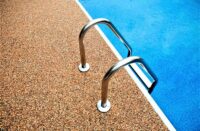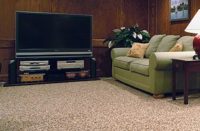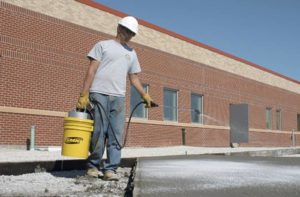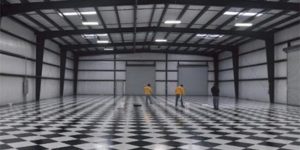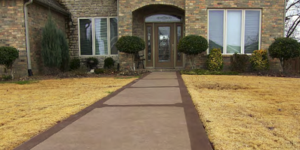A garage floor is one heck of a challenging place for the beautiful artwork and skillful craftsmanship of a decorative concrete application. Hot tires, oil, battery acid, brake fluid and strong coffee make daily assaults on an applicator’s masterpiece.
But the growing market for elaborate decorative floors in commercial and residential garages is a testament to the versatility and durability of decorative concrete. The garage floor is where decorative concrete proves it’s more than just a pretty face. These are the types of floors that are meant to stay beautiful in ugly conditions.
Garage floor system suppliers say that when done right, floor maintenance is the easiest job in the garage. Floor system producers say that installers can use maintenance — or the lack of it — as a selling point.
 Contractors, for their part, should remind prospective clients that if a deck is installed without professional substrate preparation, or with cheap materials from the local big box store, concrete may be doomed to a short life in the harsh conditions of a garage.
Contractors, for their part, should remind prospective clients that if a deck is installed without professional substrate preparation, or with cheap materials from the local big box store, concrete may be doomed to a short life in the harsh conditions of a garage.
After using all of your prep skills and the right materials, the last step is sharing some cleaning and maintenance tips with the new owner of the floor. There are several manufacturers of one-day systems that offer limited lifetime warranties. Here’s a look at long-term care for decorative garage decks.
Mike Meursing is the president of Versatile Building Products, Carson, Calif., which offers the Roll On Rock System 4h. He says that Versatile’s epoxy urethane-polyurea hybrid system eliminates substrate contamination or penetrating stains. Maintenance is minimal, he says. “If you use a good system there is no maintenance to be done. That’s not an issue with our products.”
Most garage floor systems consist of a primer, a base coat and a topcoat made from a UV-resistant material. The various available combinations of epoxies, polyurethane, polyurea and polyaspartic coatings seal so well that stains and delamination are not generally an issue if the substrate is prepared properly. Color flakes are also safe from stain, and the UV-resistant type will resist fading or yellowing.
Typical stain-makers in a garage are dirt and debris, hot tires, motor oil, grease, fuel, salts, hydraulic fluids, solvents, wiper fluids, spilled paint and tire dressings like Armor All. On an unsealed or uncoated concrete floor, most of these materials will penetrate and leave a stain, and worse, might shorten the life of the surface.
With a properly coated decorative garage floor, all of these materials can be wiped up and cleaned with water. Most manufacturers say that these glossy floors are good for about 10 to 15 years in a high-traffic environment. The surface can be rehabbed with a new topcoat, Meursing says.
 Sealing is part of the process, say garage floor system manufacturers such as Patrick Ilfrey, president of Citadel Floor Finishing Systems. Concrete that is not sealed is susceptible to damage and staining. Coated concrete will not deteriorate, he says. “Also, unsightly stains are a thing of the past. Once our coatings cure, they form a completely nonporous surface that oil, salts, gas, spills and bacteria cannot bond to.”
Sealing is part of the process, say garage floor system manufacturers such as Patrick Ilfrey, president of Citadel Floor Finishing Systems. Concrete that is not sealed is susceptible to damage and staining. Coated concrete will not deteriorate, he says. “Also, unsightly stains are a thing of the past. Once our coatings cure, they form a completely nonporous surface that oil, salts, gas, spills and bacteria cannot bond to.”
While these garage surfaces are tough, there are a few simple practices that customers can employ to extend the life and good looks of those designs that you provided for them.
Ilfrey says that pressure-washing the entire floor once a month could extend the life of the surface layer to 20 years. Spot stains can be addressed with a mild detergent, like Simple Green. Manufacturers such as Franmar Chemical offer soy-based solvents and degreasers. Harsh cleaners — particularly bleach — should not be applied.
Installers can also advise clients that certain materials should be cleaned up immediately, namely brake fluid and battery acid, said Jason Jantzen of Slide-Lok, which offers a color-chip system with a polyaspartic base. These spills will damage the surface of just about anything if left standing long enough.
So to keep your showpiece looking its best for years despite taking the worst, be sure to educate clients on these simple maintenance tips.

